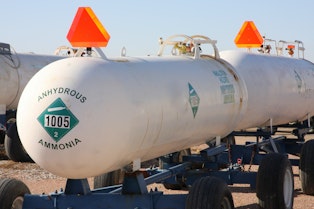It is hard to escape the hype around green hydrogen as companies jostle to issue projects announcements. There is no doubt hydrogen has tremendous potential and is an important focus for Australian industry, as evidenced by a recent announcement regarding another gas: ammonia.
Green hydrogen is made from renewable energy with close to zero emissions. But hydrogen is much harder to store and move around than oil or natural gas, so it needs to be turned into something else if it is not going to be used immediately.
Step forward 'green ammonia', in which three atoms of hydrogen are bound to one of nitrogen to form a gas that is still toxic but easier to handle than hydrogen.
This cost-efficient and marginally less high-maintenance cousin of green hydrogen is already looking integral to a world powered by clean energy.

The Australian government is looking to achieve net zero emissions by 2050, and part of that plan depends on the production of green ammonia. An ambitious hydro and solar facility, on the River Ord, in Western Australia, is a testament to Australia’s long-term objective.
The East Kimberley Clean Energy Project, powered by solar and hydro energy, is a ground-breaking initiative that aims to help Australia become a pioneering exporter of green ammonia.
At a cost of AUD$3 billion, the project’s initial phase involves integrating a 900 MW solar project with existing hydro power and port facilities, then adding electrolysers to become the nation’s first completely renewable energy hydrogen and ammonia production hub.
The project will see a 2,000-hectare solar farm developed on land owned by the MG Corporation and the Balanggarra Aboriginal Corporation, near Kununurra, in partnership with the Kimberley Land Council and advisory firm Pollination.
The resulting gigawatt or so of solar energy will be combined with hydro from the Ord Hydro Power Plant, at Lake Argyle, to produce green hydrogen from the electrolysis of water.
This green hydrogen will be transported by pipeline to Balanggarra Country, in Wyndham, where it will be converted to green ammonia. The ammonia will be sold locally as a fertiliser for irrigated agriculture—and exported to support the decarbonisation of food production and fertilisers.
Production is due to start in 2028, with a target of generating 50,000 tonnes of green hydrogen and 250,000 tonnes of green ammonia every year, primarily for export to customers in north Asia.
Rob Grant, head of projects at Pollination, said: “This project represents a just, ambitious and achievable vision for Australia’s clean energy future.
“It leverages natural advantages and existing energy and port infrastructure already in place in the East Kimberley region to create a major new clean energy export hub that will help Australia and our region decarbonise.”
The project will also help grow new industries and “ensure transitional owners and local residents are shareholders, not just stakeholders, in the benefits,” he said.

With coal and gas currently Australia’s second and third-largest sources of export revenue, the government is keen to support alternative fuels that can serve as exports in a low-carbon world.
In 2019, Australia launched a hydrogen strategy with 57 actions that focussed on national coordination, production capacity development, local demand, responsive regulation, skills, workforce, engagement with the international community and research and development.
Forecasts are promising. Global production capacity of ammonia is expected to expand to almost 290 million tonnes by 2030, from around 235 million tonnes in 2019. In 2008, the industrial production of ammonia was said to represent 1% of global energy use.
Green ammonia is seen as a promising option for decarbonisation of several industries that currently rely on fossil fuels. A significant advantage is that it is already a widely traded commodity, which means there are vessels and storage facilities around the world designed to handle it.
Today, industrial ammonia production leads to almost 2% of global emissions, but these can be largely eliminated if the compound is made from green hydrogen. In the short term, green ammonia could be used to decarbonise sectors such as fertilizers.
Around 80% of current ammonia production is dedicated to fertiliser production, while the remaining portion finds application in various sectors including refrigeration, water purification, plastics, textiles, pesticides and cleaning agents.
Considering the size of the global fertiliser market, this presents a huge opportunity for Australia’s fledgling green hydrogen industry.
The Middle East is also looking at green ammonia production, and other regions that want to export hydrogen will, like Australia, almost certainly end up selling ammonia. The market for green ammonia does not stop at replacing existing supplies but could expand as more use cases emerge.
For example, green ammonia is one of the fuels being looked at for low-carbon propulsion in the shipping industry. As cracking technology matures, it could also become cost effective to break up green ammonia molecules and extract the hydrogen for other industrial uses.
There is even the possibility of using ammonia in energy generation, for example linked to concentrated solar power (CSP).
Researchers say the Haber-Bosch ammonia synthesis process could significantly reduce the cost of CSP with storage, because ammonia could be stored in a single-tank on site and, for large volumes, underground in drilled shafts or salt caverns.
The argument for green ammonia widens when other ways to create it come into play. Plans to produce low carbon green hydrogen have focused on the electrolysis of water using low-cost electricity from wind or solar power but CSP offers an alternative.
At the Sandia National Laboratories, in the US, that’s the goal of an ambitious solar-thermal ammonia production (STAP) programme.
STAP aims to develop a novel solar thermochemical looping technology to produce and store nitrogen from air, for the subsequent production of ammonia. It will produce the energy-rich fuel from sunlight, air and hydrogen, with a minimal carbon footprint.
Meanwhile, the East Kimberley Clean Energy Project shows what is possible with green ammonia already. At Pacific Green, we see green ammonia as a major opportunity for businesses and continue to seek partners interested in taking projects to the next stage.
Publish date: 07 December, 2023